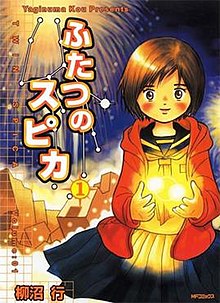| Twin Spica | |
 Cover art of the first Twin Spica manga volume featuring lead character Asumi Kamogawa | |
| ふたつのスピカ (Futatsu no Supika) | |
|---|---|
| Genre | Coming-of-age, science fiction[1][2] |
| Manga | |
| Written by | Kou Yaginuma |
| Published by | Media Factory |
| English publisher | |
| Magazine | Comic Flapper |
| Demographic | Seinen |
| Original run | September 5, 2001 – August 5, 2009 |
| Volumes | 16 |
| Anime television series | |
| Directed by | Tomomi Mochizuki |
| Written by | Rika Nakase |
| Music by | Kazunori Miyake |
| Studio | Group TAC |
| Original network | NHK BS2 |
| English network | |
| Original run | November 1, 2003 – March 27, 2004 |
| Episodes | 20 |
| Television drama | |
| Directed by |
|
| Written by |
|
| Music by | Atsushi Umehori |
| Original network | NHK General TV, NHK BS Hi-Vision |
| Original run | June 18, 2009 – July 30, 2009 |
| Episodes | 7 |
Twin Spica (Japanese: ふたつのスピカ, Hepburn: Futatsu no Supika) is a Japanese manga series written and illustrated by Kou Yaginuma. The "realistic, slice-of-life science fiction series" tells the story of a group of Japanese high school students training to become astronauts in the early 21st century after the country's first human spaceflight launch ends in a disaster that causes many civilian casualties. It was serialized in the seinen manga magazine Comic Flapper from September 2001 to August 2009 and was later published in 16 tankōbon volumes by Media Factory from January 2002 to October 2009.
The series is named after Spica, a binary star system and the brightest star in the constellation Virgo. In the manga, Yaginuma includes many references to historical events related to the development of human spaceflight as well as literary works such as Kenji Miyazawa's novel Night on the Galactic Railroad. American publishing company Vertical announced acquisition of the manga's license for English-language translation at the New York Anime Festival in September 2009, and the translated first volume was published in May 2010. The series was described by Vertical marketing director Ed Chavez as "technically sound" and "heartfelt" during its initial assessment.
The manga was adapted into an anime television series by animation studio Group TAC. It premiered on November 1, 2003, on Japan's NHK BS2 satellite channel. Twenty episodes of the anime aired until March 27, 2004, when the series concluded prematurely before the manga was completed. Satellite television network Animax has broadcast the anime in multiple regional language releases, including English. A live-action adaptation was produced by NHK in cooperation with the Japan Aerospace Exploration Agency and aired between June 18 and July 30, 2009.
- ^ "Afro Samurai, Eva: 2.22, Twin Spica Previews Posted". Anime News Network. Retrieved July 28, 2018.
- ^ "Vertical Licenses 4 Seinen Series". ICv2. October 1, 2009. Retrieved November 17, 2009.